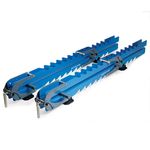Tool Test: Miter Gauges
We compare eight models to see which are the most accurate and easy to use
Synopsis: A crucial tablesaw accessory, the miter gauge ensures safe, accurate crosscuts on boards and small panels and is great for joinery cuts, too. But the stock gauge provided with most new tablesaws can be problematic. That’s why there’s a market for high quality, aftermarket gauges. We looked at eight fully equipped gauges and tested them for accuracy, ease of adjustment, and quality of cut. Models tested include: Incra 1000 HD, Incra 1000 SE, Incra 3000 SE, JDS Accu-miter, Kreg, Osborne EB-3, Ridgid, and Woodhaven 4911K.
A great tablesaw setup should include a great miter gauge as part of the package. This important accessory ensures safe, accurate crosscuts on boards and small panels and is great for joinery cuts, too. Unfortunately, the gauges provided with most new tablesaws often are less than ideal, with play in the miter-slot fit that can’t be tuned, a head that’s hard to read and set, and a fence that’s too small (or nonexistent) to support your work.
Fortunately, several manufacturers have designed high-quality, aftermarket gauges that address these issues. I looked at eight fully equipped gauges (with fence) and put them through the gauntlet to try and find the ultimate companion to a good tablesaw. Before getting to the test, though, let’s look at the key parts of a miter gauge.
What makes a good miter gauge
A miter gauge has three main parts that must work well together to ensure accuracy: a bar, a head, and a fence. The bar must slide in the slot without play, the head should offer a means of setting the gauge easily and accurately to a desired angle, and the fence should support the material firmly and provide a mounting place for stops or a rule.
Miter bar keeps the gauge on track—If the miter bar that guides the gauge doesn’t fit in the tablesaw’s miter slot, any pressure placed on the gauge while cutting will throw it out of line with the sawblade. This gives you inaccurate angles and joints that fit poorly. To remedy this, most gauges feature a way to adjust the fit of the bar so that it slides smoothly in the track. A gauge that can’t be adjusted will make imprecise cuts.
Head ensures accurate angles—The head is the heart of the gauge, the key to accurate square or angled cuts. The scale must be precise and easy to read. Positive stops, or detents, at common angles are a plus. Adjustments should be quick and easy to make, while solid enough to avoid being bumped from a setting in use. Because the head is where you hold the gauge as you push stock through the blade, it should also have a handle that is comfortable and easy to grasp.
Photos: Dillon Ryan
For the full article, download the PDF below:
Fine Woodworking Recommended Products

Rockler Deluxe Panel Clamp

Veritas Standard Wheel Marking Gauge

Dividers






















Log in or create an account to post a comment.
Sign up Log in